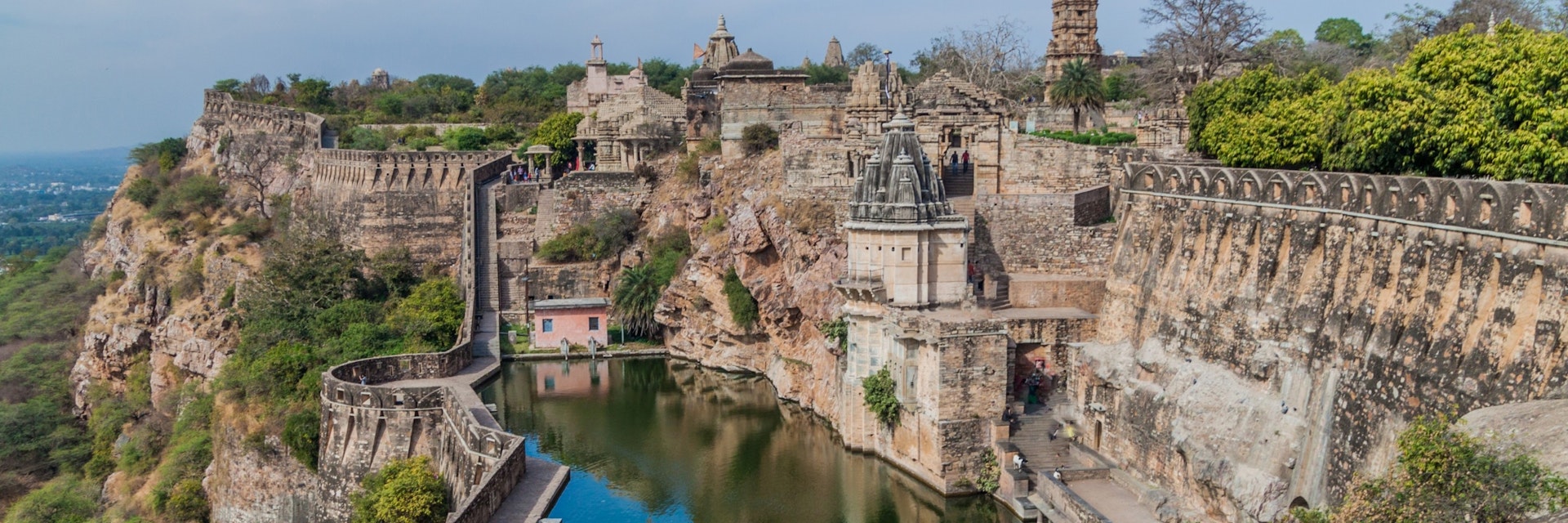A zigzag ascent of more than 1km starts at Padal Pol and leads through six gateways to the main gate on the western side, the Ram Pol (the former back entrance). Inside Ram Pol is a still-occupied village (turn right here for the ticket office). The rest of the plateau is deserted except for the wonderful palaces, towers and temples that survive from the fort's heyday, along with a few recent temples. A loop road runs around the plateau.
A typical vehicular exploration of the fort takes two to three hours. Licensed guides charging around ₹400 for up to four hours are available for either walking or autorickshaw tours, usually at the ticket office. There's a sound-and-light show at dusk (Hindi/English ₹100/200); the English show is on Fridays.
Meera & Kumbha Shyam Temples
Both of these temples southeast of the Rana Kumbha Palace were built by Rana Kumbha in the ornate Indo-Aryan style, with classic, tall sikharas (spires). The Meera Temple, the smaller of the two, is now associated with the mystic-poetess Meerabai, a 16th-century Mewar royal who was poisoned by her brother-in-law but survived due to the blessings of Krishna. The Kumbha Shyam Temple is dedicated to Vishnu and its carved panels illustrate 15th-century Mewar life.
Tower of Victory
The glorious Tower of Victory, symbol of Chittorgarh, was erected by Rana Kumbha in the 1440s, probably to commemorate a victory over Mahmud Khilji of Malwa. Dedicated to Vishnu, it rises 37m in nine exquisitely carved storeys, and you can climb the 157 narrow stairs (the interior is also carved) to the 8th floor, from where there’s a good view of the area.
Below the tower, to the southwest, is the Mahasati area, where there are many sati (ritual suicide of widow on husband’s funeral pyre) stones – this was the royal cremation ground and was also where 13,000 women committed jauhar (ritual mass suicide by immolation) in 1535. The Samidheshwar Temple, built in the 6th century and restored in 1427, is nearby. Notable among its intricate carving is a Trimurti (three-faced) figure of Shiva.
Gaumukh Reservoir
Walk down beyond the Samidheshwar Temple and at the edge of the cliff is a deep tank, the Gaumukh Reservoir, where you can feed the fish. The reservoir takes its name from a spring that feeds the tank from a gaumukh (cow’s mouth) carved into the cliffside.
Padmini’s Palace
Continuing south, you reach the Kalika Mata Temple, an 8th-century sun temple damaged during the first sacking of Chittorgarh and then converted to a temple for the goddess Kali in the 14th century. Padmini’s Palace stands about 250m further south, beside a small lake with a central pavilion. The bronze gates to this pavilion were carried off by Akbar and can now be seen in Agra Fort.
Suraj Pol & Tower of Fame
Suraj Pol, on the fort’s east side, was the main gate and offers fantastic views across the cultivated plains. Opposite is the Neelkanth Mahadev Jain Temple. A little further north, the 24m-high Tower of Fame, dating from 1301, is smaller than the Tower of Victory. Built by a Jain merchant, the tower is dedicated to Adinath, the first Jain tirthankar (one of the 24 revered Jain teachers) and is decorated with naked figures of various other tirthankars, indicating that it is a monument of the Digambara (sky-clad) order. A narrow stairway leads up the seven storeys to the top. Next door is a 14th-century Jain temple.

